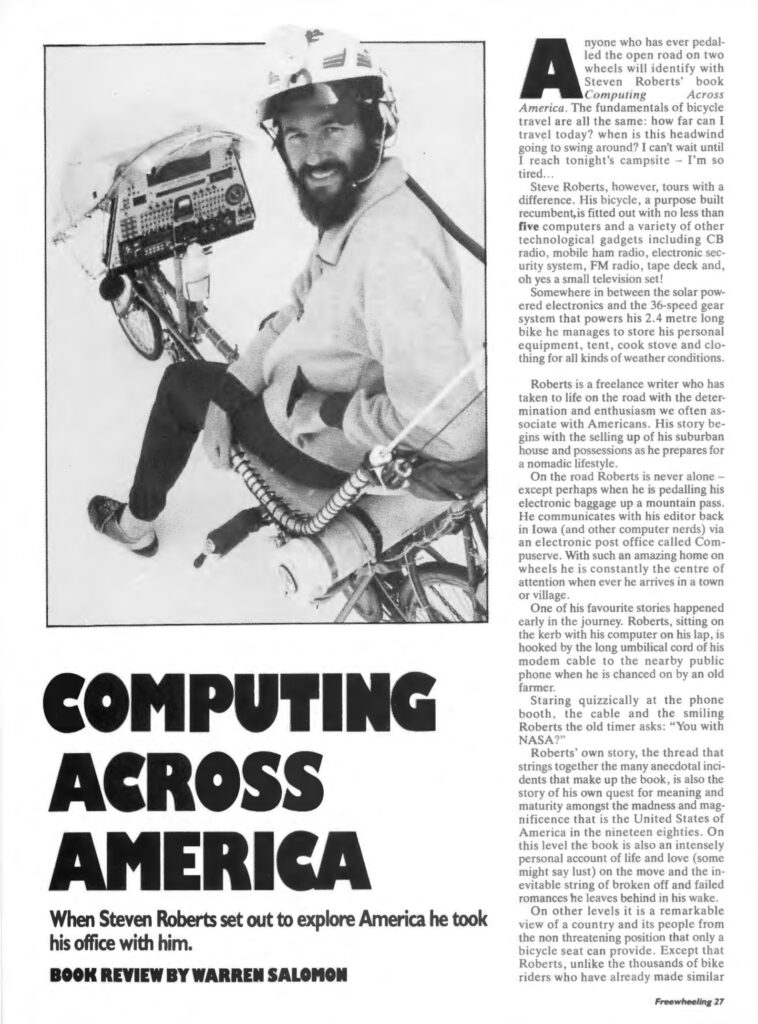
Winnebiko II in Freewheeling – Australia
This beautiful cycling magazine was published by Warren Salomon in Australia from 1977 to 1989, and covers a huge range of history. In the July/August 1988 issue, he reviewed my Computing Across America book just after it came out, then graciously gave me the space to describe the Winnebiko II in detail. For decades I have had a rough photocopy in one of my media binders, but was delighted to discover that he has since put the entire archive of Freewheeling online in the form of searchable PDFs. I extracted the article (thanks, Warren!) and am pleased to offer it here…

Computing Across America
by Steven K. Roberts
Book Review by Warren Salomon
Freewheeling
July/August, 1988
Anyone who has ever pedalled the open road on two wheels will identify with Steven Roberts’ book Computing Across America. The fundamentals of bicycle travel are all the same: how far can I travel today? when is this headwind going to swing around.? I can’t wait until I reach tonight’s campsite – I’m so tired…
Steve Roberts, however, tours with a difference. His bicycle, a purpose built recumbent, is fitted out with no less than five computers and a variety of other technological gadgets including CB radio, mobile ham radio, electronic security system, FM radio, tape deck and, oh yes a small television set!
Somewhere in between the solar powered electronics and the 36-speed gear system that powers his 2.4 metre long bike he manages to store his personal equipment, tent, cook stove and clothing for all kinds of weather conditions.
Roberts is a freelance writer who has taken to life on the road with the determination and enthusiasm we often associate with Americans. His story begins with the selling up of his suburban house and possessions as he prepares for a nomadic lifestyle.
On the road Roberts is never alone — except perhaps when he is pedalling his electronic baggage up a mountain pass. He communicates with his editor back in Ohio (and other computer nerds) via an electronic post office called CompuServe. With such an amazing home on wheels he is constantly the centre of attention when ever he arrives in a town or village.
One of his favourite stories happened early in the journey. Roberts, sitting on the kerb with his computer on his lap, is hooked by the long umbilical cord of his modem cable to the nearby public phone when he is chanced on by an old farmer.
Staring quizzically at the phone booth , the cable and the smiling Roberts the old timer asks: “You with NASA?”
Roberts’ own story, the thread that strings together the many anecdotal incidents that make up the book, is also the story of his own quest for meaning and maturity amongst the madness and magnificence that is the United States of America in the nineteen eighties. On this level the book is also an intensely personal account of life and love (some might say lust) on the move and the inevitable string of broken off and failed romances he leaves behind in his wake.
On other levels it is a remarkable view of a country and its people from the non threatening position that only a bicycle seat can provide. Except that Roberts, unlike the thousands of bike riders who have already made similar transcontinental journeys, isn’t a background character. His lean and lanky frame (he is over six feet tall) and his high tech machinery are decidedly larger than life and it doesn’t take long for the media vultures to track him down.
He certainly provides enough bait. Initially he goes looking for publicity to satisfy the needs of an initial corporate sponsor but once he becomes known he is tracked down by camera crews and reporters in even the most out of the way places . Through the South he becomes a kind of celebrity on two wheels leaving a trail of newspaper, radio and television stories as he heads across Texas bound for the Pacific.
Computing Across America as the title suggests is also about the ‘new era of electronic communications.’ It is definitely not for the Luddites among us who won’t associate with anything more high-tech than an electric stove. The book gives a wondrous insight into the world of electronic communications like the amazing online special interest groups where two or more people ‘talk’ to each other by computer and phone line no doubt adding to the vast profits of the American phone companies in the process.
It is this aspect of the book that Roberts embraces with almost zealous fervour. He sets out to prove to himself that it is possible through the use of computers and high-tech communications to maintain the semblance of an ‘ordinary’ working lifestyle while at the same time living the life of a traveller.
He may be regarded by the disbelievers as a modern day eccentric but he provides above all another living example of what can be done when the human probable is transformed into the human possible.
The only doubts planted in my mind by this witty and highly enjoyable book concern the technology its self. Having the ability to do something thanks to computers doesn’t necessarily mean that it will be done well or to the benefit of humanity. “We have the technology” is often the catchcry of those who want to unleash even more frightening and destructive power upon the world. And having a computer to write a book doesn’t mean a better book if the author can’t communicate with the readers.
Travel writers in the past wrote their journals in the field; the final manuscripts were always written at home later on a typewriter or lately on a word processor.
Roberts takes his electronic office everywhere he goes but that doesn’t necessarily make him a better writer. Though you have to admire him for it especially if you are, like me, a sucker for the silicon chip.
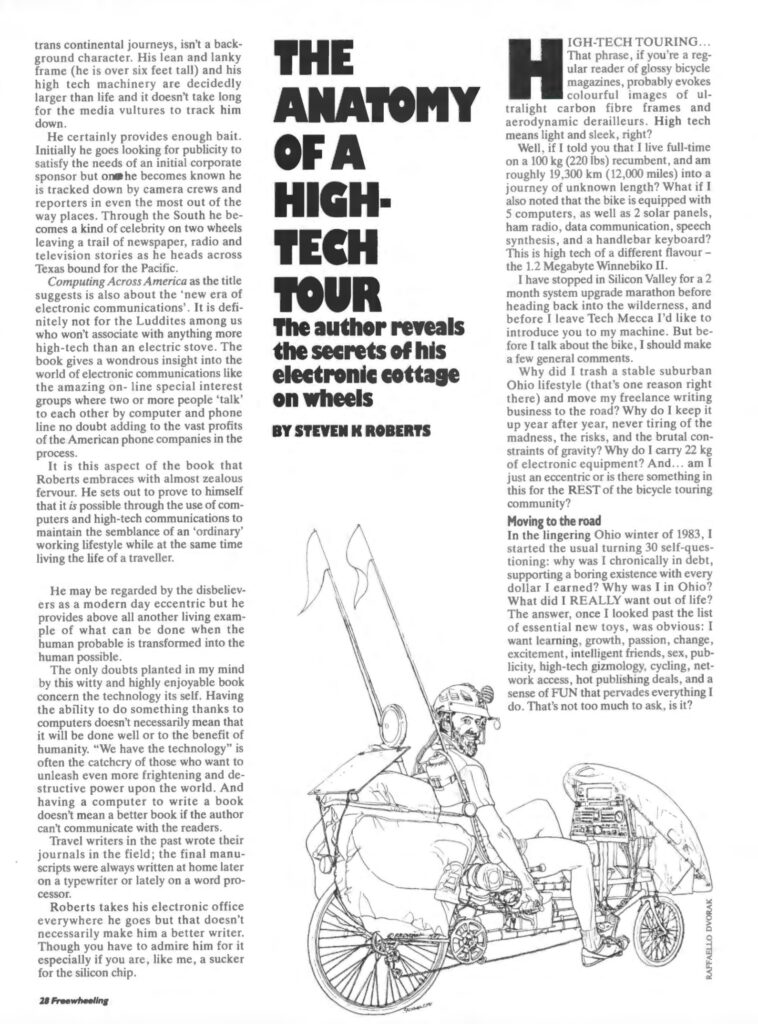
The Anatomy of a High-Tech Tour
by Steven K. Roberts
The author reveals the secrets of his electronic cottage on wheels
HIGH-TECH TOURING… That phrase, if you’re a regular reader of glossy bicycle magazines, probably evokes colourful images of ultralight carbon fibre frames and larger than life aerodynamic derailleurs. High tech means light and sleek, right?
Well, what if I told you that I live full-time on a 100 kg (220 lbs) recumbent, and am roughly 19,300 km (12,000 miles) into a journey of unknown length? What if I also noted that the bike is equipped with 5 computers, as well as 2 solar panels, ham radio, data communication, speech synthesis, and a handlebar keyboard? This is high tech of a different flavour – the 1.2 Megabyte Winnebiko II.
I have stopped in Silicon Valley for a 2 month system upgrade marathon before heading back into the wilderness, and before I leave Tech Mecca I’d like to introduce you to my machine. But before I talk about the bike, I should make a few general comments.
Why did I trash a stable suburban Ohio lifestyle (that’s one reason right there) and move my freelance writing business to the road? Why do I keep it up year after year, never tiring of the madness, the risks, and the brutal constraints of gravity? Why do I carry 22 kg of electronic equipment? And… am I just an eccentric or is there something in this for the REST of the bicycle touring community?
Moving to the Road
In the lingering Ohio winter of 1983, I started the usual turning 30 self-questioning: why was I chronically in debt, supporting a boring existence with every dollar I earned? Why was I in Ohio? What did I REALLY want out of life? The answer, once I looked past the list of essential new toys, was obvious: I want learning, growth, passion, change, excitement, intelligent friends, sex, publicity, high-tech gizmology, cycling, network access, hot publishing deals, and a sense of FUN that pervades everything I do. That’s not too much to ask, is it?
My real world, in the context of all that, felt like prison. The solution was self-evident… all I had to do was pack a portable computer onto a recumbent bicycle and travel the country, supporting myself by freelance writing along the way and using computer networks as my “enclave of stability.” No problem.
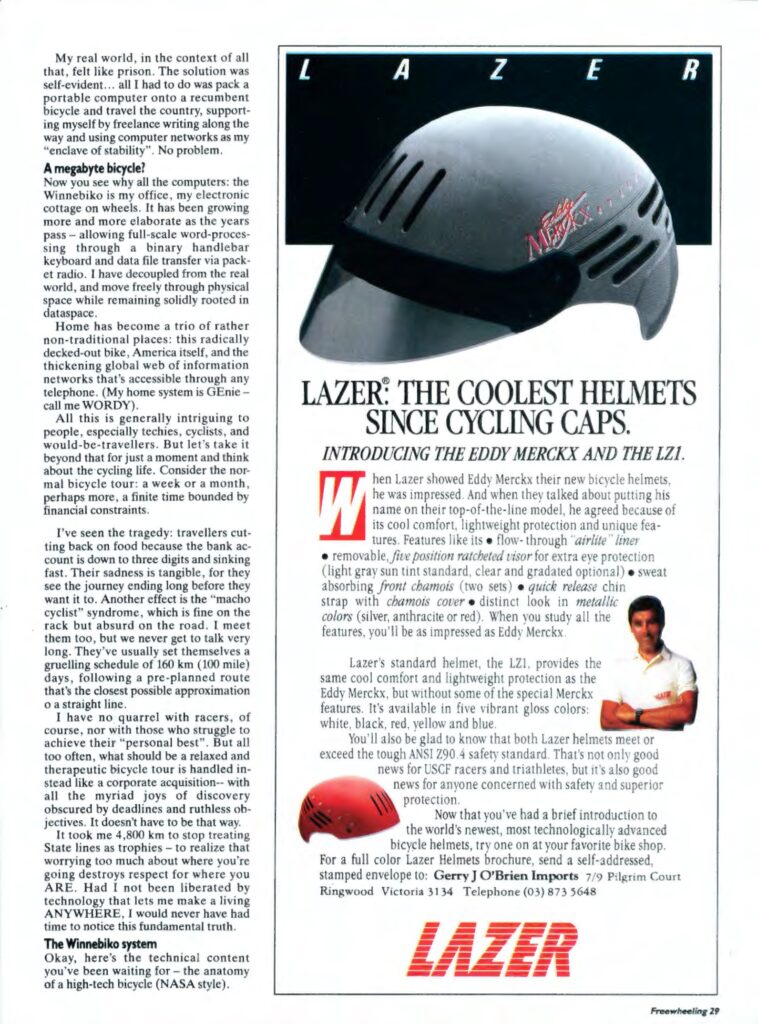
A Megabyte Bicycle?
Now you see why all the computers: the Winnebiko is my office, my electronic cottage on wheels. It has been growing more and more elaborate as the years pass – allowing full-scale word-processing through a binary handlebar keyboard and data file transfer via packet radio. I have decoupled from the real world, and move freely through physical space while remaining solidly rooted in dataspace.
Home has become a trio of rather non-traditional places: this radically decked-out bike, America itself, and the thickening global web of information networks that’s accessible through any telephone. (My home system is GEnie – call me WORDY).
All this is generally intriguing to people, especially techies, cyclists, and would-be-travellers. But let’s take it beyond that for just a moment and think about the cycling life. Consider the normal bicycle tour: a week or a month, perhaps more, a finite time bounded by financial constraints.
I’ve seen the tragedy: travellers cutting back on food because the bank account is down to three digits and sinking fast. Their sadness is tangible, for they see the journey ending long before they want it to. Another effect is the “macho cyclist” syndrome, which is fine on the rack but absurd on the road. I meet them too, but we never get to talk very long. They’ve usually set themselves a gruelling schedule of 160 km (100 mile) days, following a pre-planned route that’s the closest possible approximation to a straight line.
I have no quarrel with racers, of course, nor with those who struggle to achieve their “personal best.” But all too often, what should be a relaxed and therapeutic bicycle tour is handled instead like a corporate acquisition– with all the myriad joys of discovery obscured by deadlines and ruthless objectives. It doesn’t have to be that way.
It took me 4,800 km to stop treating State lines as trophies – to realize that worrying too much about where you’re going destroys respect for where you ARE. Had I not been liberated by technology that lets me make a living ANYWHERE, I would never have had time to notice this fundamental truth.
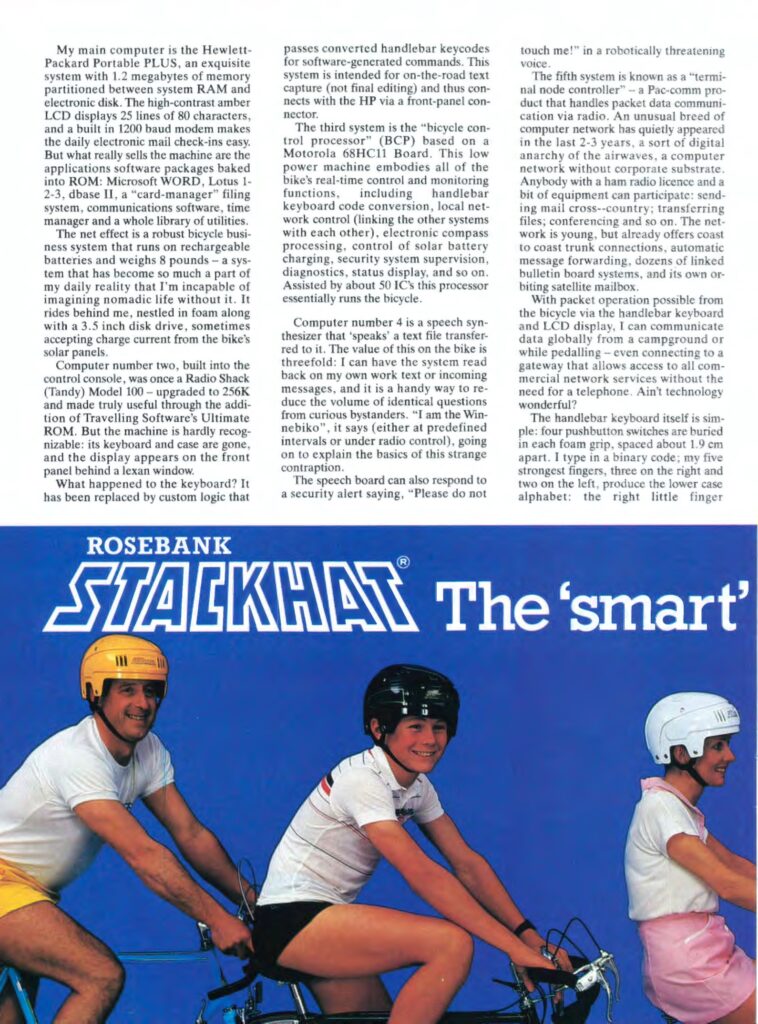
The Winnebiko system
Okay, here’s the technical content you’ve been waiting for – the anatomy of a high-tech bicycle (NASA style).
My main computer is the Hewlett-Packard Portable PLUS, an exquisite system with 1.2 megabytes of memory partitioned between system RAM and electronic disk. The high-contrast amber LCD displays 25 lines of 80 characters, and a built in 1200-baud modem makes the daily electronic mail check-ins easy. But what really sells the machine are the applications software packages baked into ROM: Microsoft WORD, Lotus 1-2-3, dbase II, a “card-manager” filing system, communications software, time manager and a whole library of utilities.
The net effect is a robust bicycle business system that runs on rechargeable batteries and weighs 8 pounds – a system that has become so much a part of my daily reality that I’m incapable of imagining nomadic life without it. It rides behind me, nestled in foam along with a 3.5 inch disk drive, sometimes accepting charge current from the bike’s solar panels.
Computer number two, built into the control console, was once a Radio Shack (Tandy) Model 100 – upgraded to 256K and made truly useful through the addition of Travelling Software’s Ultimate ROM. But the machine is hardly recognizable: its keyboard and case are gone, and the display appears on the front panel behind a Lexan window.
What happened to the keyboard? It has been replaced by custom logic that passes converted handlebar keycodes for software-generated commands. This system is intended for on-the-road text capture (not final editing) and thus connects with the HP via a front-panel connector.
The third system is the “bicycle control processor” (BCP) based on a Motorola 68HC11 Board. This low power machine embodies all of the bike’s real-time control and monitoring functions, including handlebar keyboard code conversion, local network control (linking the other systems with each other), electronic compass processing, control of solar battery charging, security system supervision, diagnostics, status display, and so on. Assisted by about 50 IC’s this processor essentially runs the bicycle.
Computer number 4 is a speech synthesizer that ‘speaks’ a text file transferred to it. The value of this on the bike is threefold: I can have the system read back on my own work text or incoming messages, and it is a handy way to reduce the volume of identical questions from curious bystanders. “I am the Winnebiko”, it says (either at predefined intervals or under radio control), going on to explain the basics of this strange contraption.
The speech board can also respond to a security alert saying, “Please do not touch me!” in a robotically threatening voice.
The fifth system is known as a “terminal node controller” — a Pac-comm product that handles packet data communication via radio. An unusual breed of computer network has quietly appeared in the last 2-3 years, a sort of digital anarchy of the airwaves, a computer network without corporate substrate. Anybody with a ham radio license and a bit of equipment can participate: sending mail cross-country; transferring files, conferencing and so on. The network is young, but already offers coast to coast trunk connections, automatic message forwarding, dozens of linked bulletin board systems, and its own orbiting satellite mailbox.
With packet operation possible from the bicycle via the handlebar keyboard and LCD display, I can communicate data globally from a campground or while pedalling – even connecting to a gateway that allows access to all commercial network services without the need for a telephone. Ain’t technology wonderful?
The handlebar keyboard itself is simple : four pushbutton switches are buried in each foam grip , spaced about 1.9 cm apart. I type in a binary code; my five strongest fingers, three on the right and two on the left, produce the lower case alphabet; the right little finger capitalizes. The left little finger is the control key, its neighbour selects numeric and special keys, and those two together cause the others to take on system level meanings such as file operations and major edit functions.
In practice, it’s easy.. a lot like playing the flute… with each combination accepted by the system when all the buttons are released.
So much for bicycle data processing. Now let’s look at the other facilities.
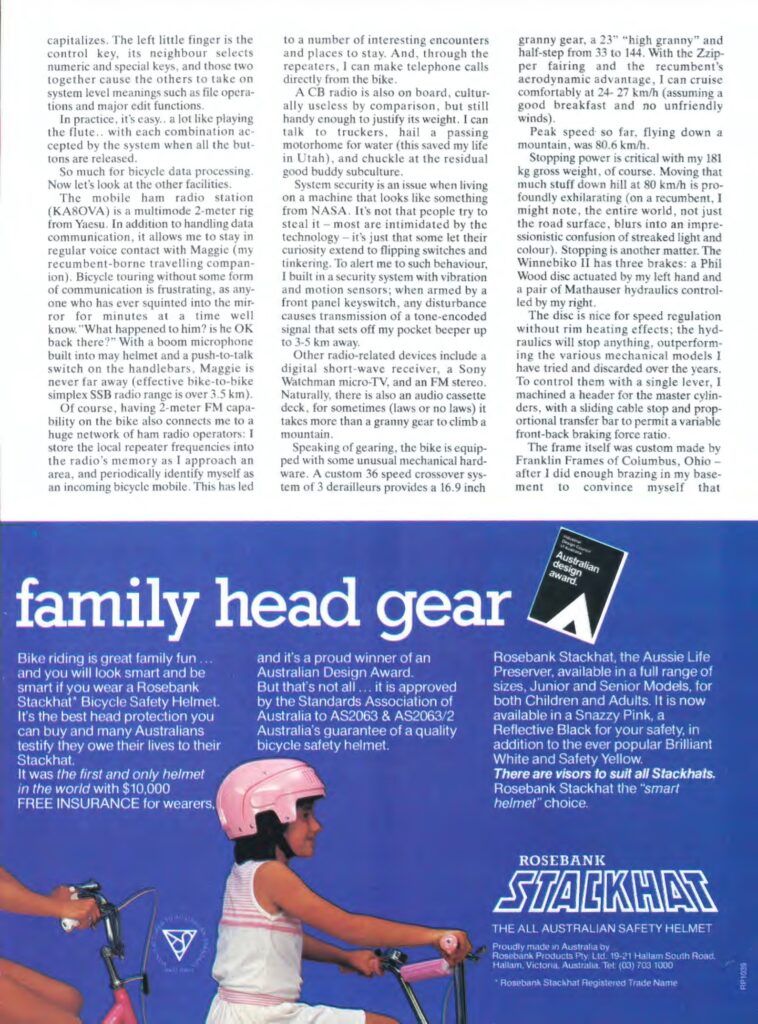
The mobile ham radio station (KA8OVA) is a multimode 2-meter rig from Yaesu. In addition to handling data communication, it allows me to stay in regular voice contact with Maggie (my recumbent-borne travelling companion). Bicycle touring without some form of communication is frustrating, as anyone who has ever squinted into the mirror for minutes at a time well know. “What happened to him? is he OK back there? ” With a boom microphone built into may helmet and a push-to-talk switch on the handlebars, Maggie is never far away (effective bike-to-bike simplex SSB radio range is over 3.5 km).
Of course, having 2-meter FM capability on the bike also connects me to a huge network of ham radio operators: I store the local repeater frequencies into the radio’s memory as I approach an area, and periodically identify myself as an incoming bicycle mobile . This has led to a number of interesting encounters and places to stay. And, through the repeaters, I can make telephone calls directly from the bike.
A CB radio is also on board, culturally useless by comparison, but still handy enough to justify its weight. I can talk to truckers, hail a passing motorhome for water (this saved my life in Utah) , and chuckle at the residual good buddy subculture.
System security is an issue when living on a machine that looks like something from NASA. It’s not that people try to steal it — most are intimidated by the technology – it’s just that some let their curiosity extend to flipping switches and tinkering. To alert me to such behaviour, I built in a security system with vibration and motion sensors; when armed by a front panel keyswitch, any disturbance causes transmission of a tone-encoded signal that sets off my pocket beeper up to 3-5 km away.
Other radio-related devices include a digital short-wave receiver, a Sony Watchman micro-TV, and an FM stereo. Naturally, there is also an audio cassette deck, for sometimes (laws or no laws) it takes more than a granny gear to climb a mountain.
Speaking of gearing, the bike is equipped with some unusual mechanical hardware. A custom 36 speed crossover system of 3 derailleurs provides a 16.9 inch granny gear, a 23-inch “high granny,” and half-step from 33 to 144. With the Zzip-per fairing and the recumbent’s aerodynamic advantage, I can cruise comfortably at 24-27 km/h (assuming a good breakfast and no unfriendly winds).
Peak speed so far, flying down a mountain, was 80.6 km/h.
Stopping power is critical with my 181 kg gross weight, of course. Moving that much stuff down hill at 80 km/h is profoundly exhilarating (on a recumbent, I might note, the entire world, not just the road surface, blurs into an impressionistic confusion of streaked light and colour). Stopping is another matter. The Winnebiko II has three brakes: a Phil Wood disc actuated by my left hand and a pair of Mathauser hydraulics controlled by my right.
The disc is nice for speed regulation without rim heating effects; the hydraulics will stop anything, outperforming the various mechanical models I have tried and discarded over the years. To control them with a single lever, I machined a header for the master cylinders, with a sliding cable stop and proportional transfer bar to permit a variable front-back braking force ratio.
The frame itself was custom made by Franklin Frames of Columbus, Ohio — after I did enough brazing in my basement to convince myself that framebuilding is an art form . The geometry is entirely custom, suited to my giraffe body and the special requirements of all this on-board hardware.
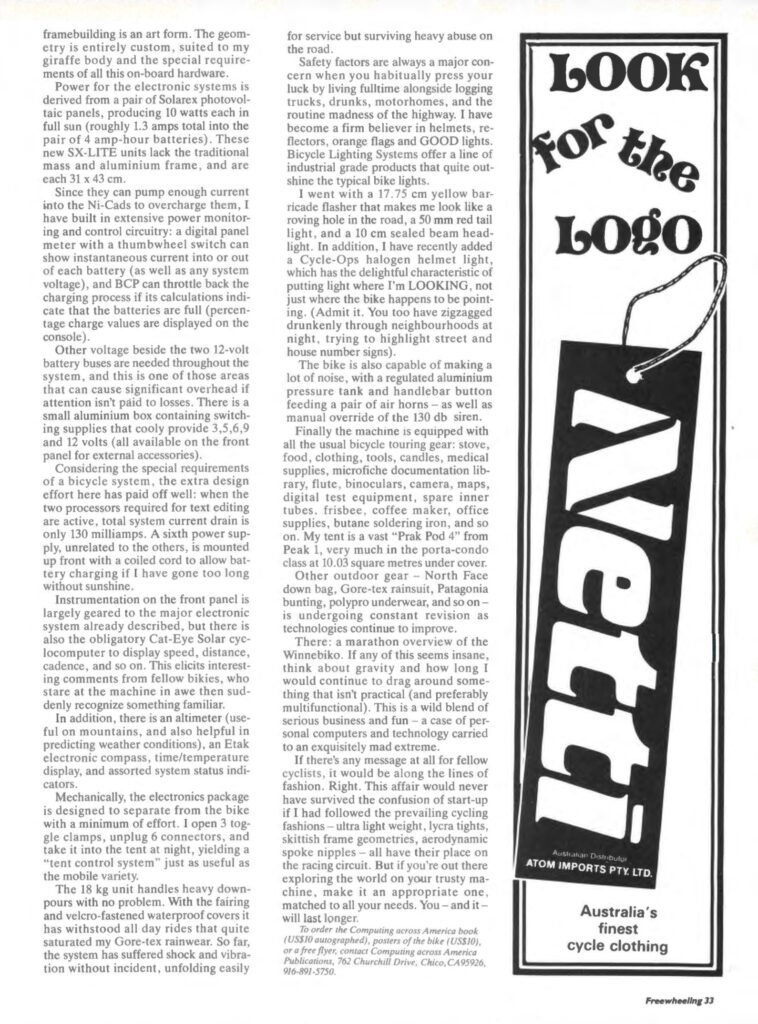
Power for the electronic systems is derived from a pair of Solarex photovoltaic panels, producing 10 watts each in full sun (roughly 1.3 amps total into the pair of 4 amp-hour batteries). These new SX-LITE units lack the traditional mass and aluminium frame, and are each 31 x 43 cm.
Since they can pump enough current into the Ni-Cads to overcharge them, I have built in extensive power monitoring and control circuitry: a digital panel meter with a thumbwheel switch can show instantaneous current into or out of each battery (as well as any system voltage), and BCP can throttle back the charging process if its calculations indicate that the batteries are full (percentage charge values are displayed on the console).
Other voltage beside the two 12-volt battery buses are needed throughout the system, and this is one of those areas that can cause significant overhead if attention isn’t paid to losses. There is a small aluminium box containing switching supplies that cooly provide 3,5,6,9 and 12 volts (all available on the front panel for external accessories).
Considering the special requirements of a bicycle system, the extra design effort here has paid off well: when the two processors required for text editing are active, total system current drain is only 130 milliamps. A sixth power supply, unrelated to the others, is mounted up front with a coiled cord to allow battery charging if I have gone too long without sunshine.
Instrumentation on the front panel is largely geared to the major electronic system already described, but there is also the obligatory Cat-Eye Solar cyclocomputer to display speed, distance, cadence, and so on. This elicits interesting comments from fellow bikies, who stare at the machine in awe then suddenly recognize something familiar.
In addition, there is an altimeter (useful on mountains , and also helpful in predicting weather conditions), an Etak electronic compass, time/temperature display, and assorted system status indicators.
Mechanically, the electronics package is designed to separate from the bike with a minimum of effort. I open 3 toggle clamps, unplug 6 connectors, and take it into the tent at night, yielding a “tent control system” just as useful as the mobile variety.
The 18 kg unit handles heavy downpours with no problem. With the fairing and velcro-fastened waterproof covers it has withstood all day rides that quite saturated my Gore-tex rainwear. So far, the system has suffered shock and vibration without incident , unfolding easily for service but surviving heavy abuse on the road.
Safety factors are always a major concern when you habitually press your luck by living fulltime alongside logging trucks, drunks, motorhomes, and the routine madness of the highway. I have become a firm believer in helmets, reflectors, orange flags and GOOD lights. Bicycle Lighting Systems offer a line of industrial grade products that quite outshine the typical bike lights.
I went with a 17.75 cm yellow barricade flasher that makes me look like a roving hole in the road, a 50 mm red tail light, and a 10 cm sealed beam headlight. In addition, I have recently added a Cycle-Ops halogen helmet light, which has the delightful characteristic of putting light where I’m LOOKING, not just where the bike happens to be pointing. (Admit it. You too have zigzagged drunkenly through neighbourhoods at night, trying to highlight street and house number signs).
The bike is also capable of making a lot of noise, with a regulated aluminium pressure tank and handlebar button feeding a pair of air horns — as well as manual override of the 130 db siren.
Finally the machine is equipped with all the usual bicycle touring gear: stove, food, clothing, tools, candles, medical supplies, microfiche documentation library, flute, binoculars, camera, maps, digital test equipment, spare inner tubes, frisbee, coffee maker, office supplies, butane soldering iron, and so on. My tent is a vast “Peak Pod 4” from Peak 1, very much in the porta-condo class at 10 square metres under cover.
Other outdoor gear — North Face down bag, Gore-tex rainsuit, Patagonia bunting, polypro underwear, and so on — is undergoing constant revision as technologies continue to improve.
There: a marathon overview of the Winnebiko. If any of this seems insane, think about gravity and how long I would continue to drag around something that isn’t practical (and preferably multifunctional). This is a wild blend of serious business and fun — a case of personal computers and technology carried to an exquisitely mad extreme.
If there’s any message at all for fellow cyclists, it would be along the lines of fashion. Right. This affair would never have survived the confusion of start-up if I had followed the prevailing cycling fashions — ultra light weight, lycra tights, skittish frame geometries, aerodynamic spoke nipples — all have their place on the racing circuit. But if you’re out there exploring the world on your trusty machine, make it an appropriate one, matched to all your needs. You — and it — will last longer.


You must be logged in to post a comment.